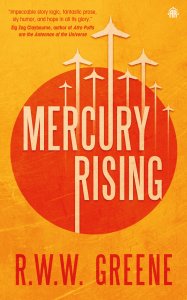Gary K. Wolfe reviews Karin Tidbeck
 For the past few years, there have been a number of salutary efforts to bring international SF to the attention of the wider community (by which I mean monolingual English-language readers) – a new translation award, recent Japanese and Latin American anthologies, sterling reviews for Angelica Gorodischer, Johanna Sinisalo, and Hannu Rajaniemi, etc. Now Cheeky Frawg books, the latest imprint by Ann & Jeff VanderMeer, is introducing us to the work of Karin Tidbeck, a young Swedish author, who like Rajaniemi also writes in English, and who promises to be one of the most distinctive new voices in short fiction since Margo Lanagan. Her collection Jagannath includes eleven stories, mostly translated from the Swedish (presumably by the author, since no translator is given), seven of which originally appeared in her 2010 collection Vem är Arvid Pekon?, though a few have appeared in English, and one is original to the collection. It’s a slim volume, and some of the stories are only a few pages long, but it’s not quite like anything you’ve seen, even though you may hear vague echoes of everyone from Kafka to Borges to Tove Jansson.
For the past few years, there have been a number of salutary efforts to bring international SF to the attention of the wider community (by which I mean monolingual English-language readers) – a new translation award, recent Japanese and Latin American anthologies, sterling reviews for Angelica Gorodischer, Johanna Sinisalo, and Hannu Rajaniemi, etc. Now Cheeky Frawg books, the latest imprint by Ann & Jeff VanderMeer, is introducing us to the work of Karin Tidbeck, a young Swedish author, who like Rajaniemi also writes in English, and who promises to be one of the most distinctive new voices in short fiction since Margo Lanagan. Her collection Jagannath includes eleven stories, mostly translated from the Swedish (presumably by the author, since no translator is given), seven of which originally appeared in her 2010 collection Vem är Arvid Pekon?, though a few have appeared in English, and one is original to the collection. It’s a slim volume, and some of the stories are only a few pages long, but it’s not quite like anything you’ve seen, even though you may hear vague echoes of everyone from Kafka to Borges to Tove Jansson.
The Borges echo is most notable in a story-disguised-as-essay called ‘‘Pyret (Py:Ret)’’, which would hardly be out of place in The Book of Imaginary Beings. It describes a benign creature called a Pyret, persisting in Swedish folklore from the time of the Icelandic sagas, sometimes mimicking other animals. What appear to be genuine scholarly citations lead to an anecdotal account from the 1860s and another from the 1970s, finally to the narrator’s own efforts to investigate the latter, which in turn leads to a surprising epiphany about the nature of her own research. There’s a Kafkaesque feel to ‘‘Arvid Pekon’’, in which a bureaucrat working in a government employment office begins receiving odd calls from a Miss Sycorax, at first wanting to speak to her dead mother, then to the Beetle King. Beetles and cockroaches begin to invade his life, possibly hallucinatorily, until his own reality is called into question. It’s governed by the same sort of horror-story dream logic that haunts Kafka’s characters, and to much the same effect. Another story, with an almost conventional but effective horror twist, is ‘‘Rebecka’’, in which the title character repeatedly attempts suicide, only to be foiled by what she believes to be acts of God, until she comes up with a chilling scheme to ‘‘do something he can’t ignore.’’
But most of Tidbeck’s stories lie firmly in her own territory, a half-mythical region most emblematically represented by the strange and brutal world shared by two stories, ‘‘Augusta Prima’’ and ‘‘Aunts’’. The former opens with what appears to be a refined game of croquet, but immediately starts going weird when we learn that the host is Mnemosyne, the pages who serve the drinks are changelings, and the goal seems to be to smash the balls into the faces of the pages. Augusta finds a putrefying corpse in a nearby wood and steals a watch from it, but needs to consult a page to even find out what it is – she and her decadent friends, not quite human, live in a twilight world outside of time, but by discovering time she learns she has fallen into it. Also on this estate is an orangery, which houses the title characters of ‘‘Aunts’’, three enormous women, tended by ‘‘nieces,’’ who ‘‘had one single holy task: to expand.’’ At a certain point, the Aunts split open from sheer enormity, and the nieces scoop out the organs, which will feed the next generation of Aunts, who begin life as fetal creatures clinging to and devouring their dead Aunts’ hearts. It’s a bizarre world, with some of the grotesque ambience of a Heinrich Kley drawing or a John Bauer painting (Bauer is alluded to in another story), that seems to leave room for additional stories – we’re told it’s only one of eight worlds, but ‘‘the most perfect one.’’
But the Aunts aren’t the most remarkable mother figures in the book; in the title story ‘‘Jagannath’’ (a name presumably drawn from the Hindu deity), survivors of an unspecified catastrophe survive by working inside an enormous biomechanical ‘‘great Mother,’’ keeping her organs functioning as she nurtures and protects them from ‘‘the horrible place’’ outside. Vaguely recalling Kit Reed’s ‘‘Perpetua’’, it’s one of the more recognizably SFnal tales in the book. So, in a way, is ‘‘Beatrice’’, which is Tidbeck’s surreal take on a steampunk romance, as a physician who has fallen in unrequited love with an airship meets a printer’s assistant who has fallen in love with a steam engine. Tidbeck has the discipline to follow such absurdist premises with a kind of fierce plot logic that almost makes them seem inevitable.
As should be apparent by now, Tidbeck often uses character names as titles – ‘‘Beatrice’’, ‘‘Augusta Prima’’, ‘‘Rebecka’’ – and this suggests her primary concern with character; even in the briefest and most elliptical of her tales, the motivations that drive her figures through these strange landscapes seem credible. She seems to view families as inherently fantastical, not only with those mythologized mother figures, but with children who might be imaged as tiny, gnarled creatures (‘‘Miss Nyberg and I’’ or ‘‘Cloudberry Jam’’, which opens with the line ‘‘I made you in a tin can’’) or parents who are remote, alienated, and in the case of ‘‘Some Letters for Ove Lindstrom’’, dead (the story is a series of letters to a dead father, which again echoes Kafka). The fullest portrayals of families are ‘‘Brita’s Holiday Village’’, in the form of the diary entries of a writer trying to complete a novel drawing on her family history, and ‘‘Reindeer Mountain’’, the collection’s one original story and possibly its best. Twelve-year-old Cilla and her sister Sara are visiting the family village, where an aging great-uncle is being moved out of a cottage he has lived alone in for decades. Cilla’s discoveries about her family, and her family’s possible involvement with the vittra, elf-like nature spirits of Swedish folklore, sets up a series of mysteries that are both emotionally authentic and genuinely eerie. It’s a gorgeously shaped tale that may not be Tidbeck’s most bizarre, but which demonstrates as well as any how her various oddities are grounded in an absolutely authentic sense of place, and a keen understanding of how the heart works, even when it isn’t assisted by shift workers inside the body.








Pingback:Karin Tidbeck’s latest collection, “Jagannath: Stories” – Europa SF – The European Science Fiction portal
Pingback:Jagannath link dump: reviews, interviews, essays « Karin Tidbeck